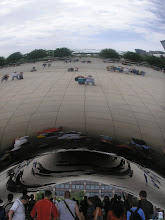Isaac Albeniz ran away from home and toured the U.S. at the age of 12, studied piano in Leipzig, Brussels, and with Liszt in Budapest, and polished his composition skills in Paris, yet he is best known for his works which depict his home country of Spain [iii]. Though Albeniz learned and performed a great deal elsewhere in the world, his dedication to more widely distributing the exotic folk music of Spain established him as a leader in Spanish nationalistic music in the Romantic period. The Romantic era was a time known for radical change, socially and politically, and Spain was not immune to its ravages. Spain in the nineteenth century was ripe with turmoil, and the lack of stability greatly suppressed many forms of art, as there were few to no major, internationally-known painters or composers in Spain from the beginning of the century until nearly the end [iii].
One of these emerging artists towards the end of the century was Isaac Albeniz. Though he studied all over the western world, his compositional style was most notably influenced by his association with Felipe Pedrell, known as “the greatest of nineteenth-century Spanish musical scholars” [iii] and as a teacher who pushed his pupils to compose using the folk music of Spain [ii]. As a result, Albeniz would write many Spanish nationalistic works, most notably for piano, including Iberia and Suite espanola.
Each work in Albeniz’s Suite espanola, a collection composed between 1886 and 1889, depicts a region of Spain and that region’s corresponding dance style. There are two suites, the first containing the titles and tone paintings of “Granada,” “Catalina,” “Sevilla,” “Cadiz,” “Asturias,” “Aragon,” “Castilla,” and “Cuba,” and the second featuring “Zaragoza” and “Sevilla.”
Many elements unify the movements. Harmonic movement is simple, often alternating between I and V. Melodies are also simple, but tuneful and lyrical. The form of the suites is essentially ternary, and the styles of the sections seem to be consistent. There is stark contrast between the A and B sections, of which Walter Clark says that Albeniz “employs the spirited rhythms… in the A section as well as stirringly lyrical and animated copla in the B section” [i]. For the most part, A sections tend to move at a more constant speed, using dancing motor rhythms in the left hand while the right hand carries lyrical melodies in short phrases. B sections contrast greatly, however, and are usually announced by abrupt breaks after the A section. These middle sections tend to be in a more rubato style. They maintain great lyricism but seem more emotional, as they are often in minor keys. While these sections do not paint a picture of Spain through dance rhythms, we do get the essence of Spain’s Moorish culture through Albeniz’s use of the Phrygian mode. Through these forms, Albeniz first catches our attention with intricate dance rhythms, gives us a glimpse of the soul of the region through its melodies, and then leaves us again with the more memorable rhythmic dance.
Aside from harmonic and melodic simplicity and abruptly contrasting sections, Albeniz is firmly in the late Romantic period through his use of chromaticism. In the “Catalina” movement the return of the theme in the second A section is accompanied by descending chromatic chords in the left hand. Chromaticism is also clearly stated in the transition between themes in the A section of “Sevilla,” in the harmonic and melodic movement of “Zaragoza,” and in the theme of “Cuba.”
As can be expected with dance-based music, rhythms also establish this work in Romantic nationalism. The meter stays pretty much rooted in 6/8. Dotted rhythms exist throughout nearly the entire “Cataluna” movement, “Castilla” features a rapid-fire rhythmic gallop in the left hand, “Zaragoza” makes use of triplets, and “Asturias,” which was my favorite movement, begins with fast ostinati in the left hand, then adds an offbeat tonic note floating above in the right hand, and finally incorporates very striking, accented chords on the downbeats in the right hand. This movement stood out to me in that the A section was almost entirely rhythmically based and portrayed the sheer intensity of the “Leyenda” dance. One thing I found interesting, though, was that there was an obvious pause or hesitation before each of these strikes. I am not sure if this was notated by Albeniz to adhere to the nature of the dance, or if it was done by choice of the performer, but I thought it was strange that a section with so much rhythmic intensity would be broken up in such a way.
While overall I enjoyed Albeniz’s Suites, the “Asturias” movement was the only one that stayed in my mind through the end. Many of the other movements were too similar, both in form and in content, and by the last movement, material recycled from earlier in the work appears. I think this work would have been better executed with fewer and more contrasting movements. When I think about what it would be like to tour Spain, I think there would be many memorable sights and experiences, but Isaac Albeniz makes it seem more like a drive across Kansas. I think this work is not included in the canon because there is simply not enough contrast among the movements. There are some great high points, such as the “Asturias,” but they are too few and far between for the piece to be considered one of the greatest nationalistic works of the Romantic period.
Bibliography
[i] Clark, Walter Aaron. Isaac Albeniz: Portrait of a Romantic. New York: Oxford University
Press, 1999.
[ii] Thompson, Wendy, Christopher Webber. “Albeniz, Isaac (Manuel Francisco).” In Oxford
Music Online, http://www.oxfordmusiconline.com.ezproxy.mnl.umkc.edu/subscriber/article/opr/t114/e146 (accessed February 20, 2009).
[iii] Samson, Jim, ed. The Late Romantic Era. New Jersey: Prentice Hall, 1991.
Subscribe to:
Post Comments (Atom)


No comments:
Post a Comment